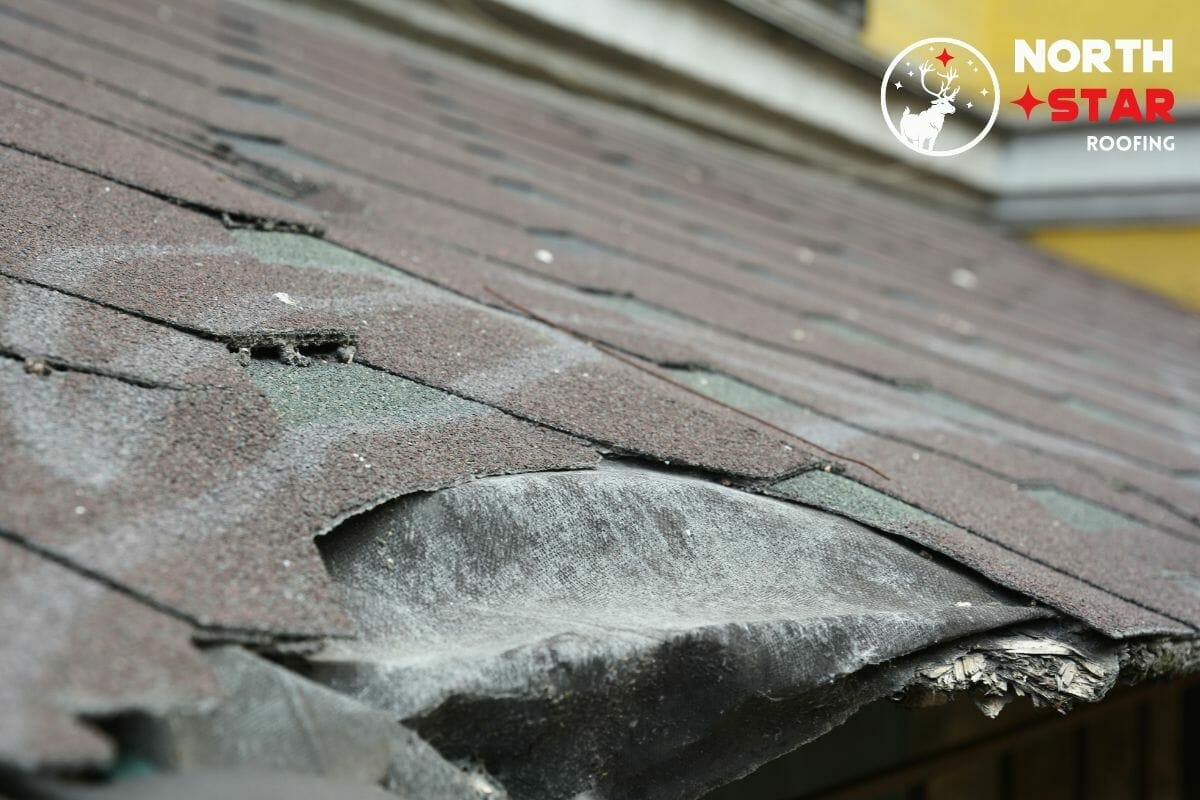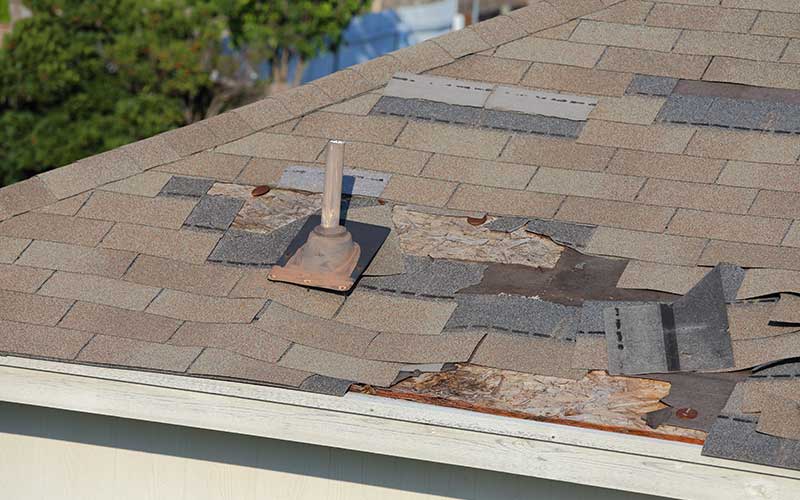If you suspect that the last storm has damaged your roof, you must take immediate action. North Star Roofing offers 24/7 emergency roofing services in and around North Wales, PA.
However, it is possible that less severe storms don’t call for an emergency. But in reality, roof storm damage can be very frustrating over time. There are chances that you may not be able to notice all the signs of damage right away.
So, to guide you on what to do after a storm hits your area, our experts have put together this blog that’ll help you:
- Identify storm damage on pitched and flat roofs.
- Make temporary fixes.
- Understand the process of storm damage repair.
- Choose a reliable roofing company.
To give you a start, we are first describing how various storms can damage pitched and flat roofs. It’ll help you determine how badly your roof might be affected.
What Does A Roof Storm Damage Look Like?
You can easily see the damage when a massive storm hits your property. If you have a pitched roof, there will be a power outage, your shingles can blow away, or an entire section of your roof can break down. Flat roofs can also shatter, damaging the HVAC units and blocking the shafts.
However, with seasonal storms, you can expect damages that may not be so evident at that time but affect your roof after some time.
Storm Damage On Pitched Roofs
In Pennsylvania, tropical storms are mostly thunderstorms with rainfall and lightning. The rest of the storms are violent tornadoes, heavy rain, and huge hailstones.
Wind
Gale-force hurricane winds and F1 tornadoes have speeds up to 70 miles per hour. They can cause visible damage to your home’s roof. Such twisting and forceful winds can uproot the shingles, exposing the underlayment and wooden decking.
However, seasonal storms can be less destructive as they hit the roof. But they are equally damaging in the long run. Roofing specialists overlap the shingles to bond them strongly, making a water-tight structure. But such storms can lift and curl the shingles, breaking this structure. You may not be able to see this damage, but it leaves your roof vulnerable and weak, which leads to leaks and moisture damage after a few times.
Hail
Hailstorms don’t last much longer, but they cause significant damage to your roof. Hailstones can crack the shingles and cause granule loss, which is not visible from below. Since granules make a protective layer over the shingles, this leaves the roof prone to sun damage, mold, termites and leaks. Hail also puts unsightly dents and cracks in the roof, affecting its appearance.
Water
Thunderstorms with heavy rain and uneven wind patterns allow the rainwater to slip inside the soffit vents, causing moisture damage to your attic. So unless you wait for signs of water damage, you won’t be able to assess roof storm damage on your own. That’s why our team at OConnor Contracting offers a free roof inspection for homes and commercial buildings; we suggest you go fir it right after the storm season passes away.
Flat Roof Storm Damage
A flat roof needs even more attention when a storm hits the building. Flat roofs don’t have gutters running along the boundary and there’s a lot of machinery and equipment on the roof, which can damage during a storm.
Pooling On The Surface
During thunderstorms, heavy rain and snowfall, flat roofs can suffer a lot of damage. Debris and water can pool on the surface, leading to moisture damage and blocks in drains. If drains don’t work properly, water will not pass through them, causing even more damage.
Blisters And Leaks
Flat roofs need seasonal checks. The corners are prone to water damage. They also require additional coating on the surface to avoid blisters and roof leaks throughout the year.
Membrane Damage
Flat roofs have a waterproof membrane usually made of rubber, asphalt and fiberglass. This membrane can shrink and cut after a few storm seasons, allowing water to pass through. This results in frequent electrical faults, high HVAC bills, and damage to the ceiling and walls.
Damage To Equipment And Surroundings
Weather alerts can tell you about an approaching storm, and you must prepare your roof for that. Cut down tall trees near your building that may fall over your roof or break through the windows.
Cover the electricals, HVAC hardware and satellite equipment on the roof. If you leave them open, they can break down and toss around, damaging the roof, towers, overhead power lines, and everything else around them.
What To Look For When The Storm Has Passed?
Your home and commercial building need a professional roof inspection after the storm season. This will tell you the exact condition of your roof, prevent potential damage and repair any roof leaks.
There are many ways to assess roof storm damage on a property. We’ve mentioned a few easy ones below.
Damage To Shingles
The first and foremost way is to check the shingles. If you don’t see any missing shingles from below, you’ll have to look for curling and cracks in the shingles.
- If you have a professional zoom camera, you can try to find it through the lens.
- Otherwise, we will never suggest you climb up the roof and inspect it without professional help.
- Usually, storms leave the shingles loose, causing them to fall over after some time. You can’t figure out loose shingles unless you touch them.
- Look around for shingle granules in your gutters and lawn. You will be looking at gravel that looks like tiny chunks of sand. Even a few flushed granules point towards roof storm damage.
Damage to Membrane
When the weather is fine, you can go up the roof and look for signs of damage. Flat roofs are easily accessible, so you can move around and look for signs of damage.
- Look for cracks in the roof, which can be evident on the edges. Sometimes, parts of the roof edge can completely shatter down during a storm.
- Check the surface of the roof for cuts and shrinks in the membrane. Generally, when we inspect a flat roof, we cut through the suspicious areas to ensure everything underneath is fine.
- Our specialists will also look for all signs of roof storm damage, including damage to the electricals, vents, insulation and seals.
Water Damage Around Leak-Prone Areas
You will notice roof leaks and moisture spots around the ceiling. Stormwater can easily seep inside your property through the leak-prone areas of your roof.
The areas of your roof with flashing or seals are prone to leaks. You can find the flashing around chimneys, skylights, vents, ducts and previously repaired parts of the roof.
Clogged Drains, Gutters Or Downspouts
If your roof’s drainage system is blocked or pulled away, it will leave the rest of your roof vulnerable to water damage.
- Storms can pull the gutters away from the roof edge, pushing the water directly onto the ground. It will affect the surface of the sundeck and foundation of your home.
- With blocked downspouts and overflowing gutters, water pooling will ruin your landscaping or lawn.
- Flat roofs usually have an internal or closed drainage system. There are a few drainage channels on the surface of flat roofs and some exterior downspouts. It would be best if you get them cleaned right before the storm season rolls in.
- Storms that are not severe will only create drainage problems if you don’t maintain the system regularly. With regular inspections and cleaning, you can avoid significant water damage to your drainage system and roof.
- You can contact our experts at North Star Roofing for yearly roof cleaning. It is extremely helpful to keep your roof sturdy and appealing.
Mold And Algae
Mold and algae are silent signs of roof storm damage and in your home. They look like puffy, green and white spots that can damage your roof’s wooden foundation.
- To find mold and algae, check the ceiling and edges of your roof. After that, look through the walls of the last room or the attic.
- If there is mold and algae growth anywhere near the roof, it means your roof is affected by moisture damage due to stagnant thunderstorm waters and melting snow.
- Mold, mildew, moss and algae are stubborn and can harm your roof beyond repair. If you find them, you should call us as soon as possible for a free roof inspection.
- We will give you a complete roof report, including what you should do and how you can proceed with the insurance claim and roof repairs.
It’s your choice to pick North Star Roofing or any other roofing contractor. However, you must beware of companies with a record of shoddy workmanship.
Hire a Reliable, Local Roofing Contractor
You should always hire an experienced and reliable roofing contractor. They usually get busy during the storm season, so keep in touch with them to receive a prompt response.
- Reading about the top roofing contractors near you is an excellent place to start your research. Credible local contractors have a license to work in your area and have insurance against accidents and injuries.
- Local roofing contractors are a part of your community. They want to maintain a good reputation through great customer service.
At North Star Roofing, our team has an outstanding track record of customer satisfaction which includes helping you with insurance claims.
Do You Need Help With Roof Storm Damage?
Experts at North Star Roofing have over 55 years of combined experience in the industry. Over the years, we have worked with many insurance companies and adjusters. This makes us one of the best professionals to give you proper guidance.
When a storm hits the area, we know nobody can stay calm. Everyone will worry about their homes and buildings. We care about you, and that’s why our team is always ready to visit your property right after the storm passes away.
At North Star Roofing, we take pride in being Owens Corning Platinum Roofing Partner. Owens Corning is USA’s leading manufacturer that produces world-class roofing materials.
- We will inspect your roof thoroughly and give you a detailed report.
- Talk to your adjuster and help you file an insurance claim.
- Explain to you the whole process of repair and replacement.
- Discuss everything about roofing materials.
If you need help with roof storm damage in North Wales, PA, you can count on North Star Roofing. We hope this blog helps you make the right decision for your home or business. If you want to fix roof leaks, you can read about it in our previous blog.
If you have any questions or concerns, call us at (484) 302-7663. We would be glad to help you.



